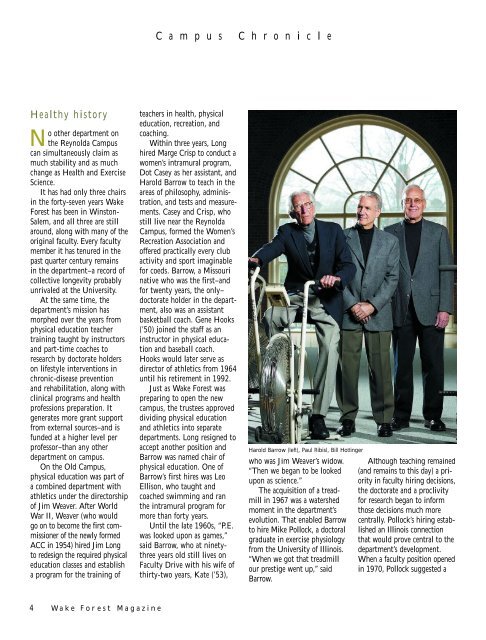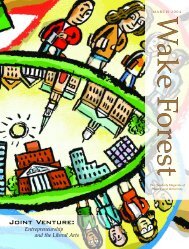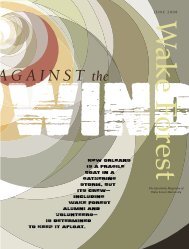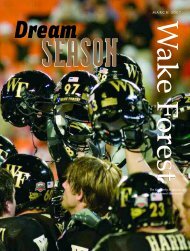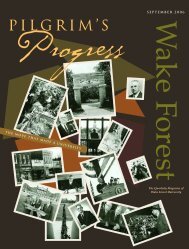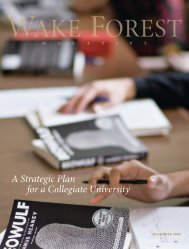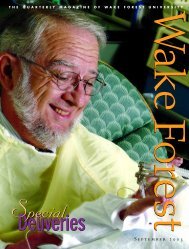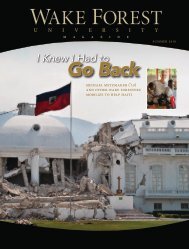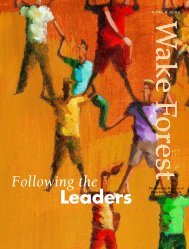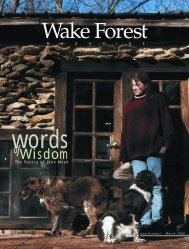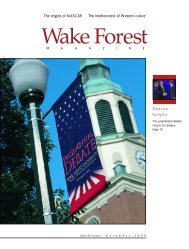Wake Forest Magazine June 2003 - Past Issues - Wake Forest ...
Wake Forest Magazine June 2003 - Past Issues - Wake Forest ...
Wake Forest Magazine June 2003 - Past Issues - Wake Forest ...
You also want an ePaper? Increase the reach of your titles
YUMPU automatically turns print PDFs into web optimized ePapers that Google loves.
C a m p u s C h r o n i c l e<br />
Healthy history<br />
No other department on<br />
the Reynolda Campus<br />
can simultaneously claim as<br />
much stability and as much<br />
change as Health and Exercise<br />
Science.<br />
It has had only three chairs<br />
in the forty-seven years <strong>Wake</strong><br />
<strong>Forest</strong> has been in Winston-<br />
Salem, and all three are still<br />
around, along with many of the<br />
original faculty. Every faculty<br />
member it has tenured in the<br />
past quarter century remains<br />
in the department–a record of<br />
collective longevity probably<br />
unrivaled at the University.<br />
At the same time, the<br />
department’s mission has<br />
morphed over the years from<br />
physical education teacher<br />
training taught by instructors<br />
and part-time coaches to<br />
research by doctorate holders<br />
on lifestyle interventions in<br />
chronic-disease prevention<br />
and rehabilitation, along with<br />
clinical programs and health<br />
professions preparation. It<br />
generates more grant support<br />
from external sources–and is<br />
funded at a higher level per<br />
professor–than any other<br />
department on campus.<br />
On the Old Campus,<br />
physical education was part of<br />
a combined department with<br />
athletics under the directorship<br />
of Jim Weaver. After World<br />
War II, Weaver (who would<br />
go on to become the first commissioner<br />
of the newly formed<br />
ACC in 1954) hired Jim Long<br />
to redesign the required physical<br />
education classes and establish<br />
a program for the training of<br />
teachers in health, physical<br />
education, recreation, and<br />
coaching.<br />
Within three years, Long<br />
hired Marge Crisp to conduct a<br />
women’s intramural program,<br />
Dot Casey as her assistant, and<br />
Harold Barrow to teach in the<br />
areas of philosophy, administration,<br />
and tests and measurements.<br />
Casey and Crisp, who<br />
still live near the Reynolda<br />
Campus, formed the Women’s<br />
Recreation Association and<br />
offered practically every club<br />
activity and sport imaginable<br />
for coeds. Barrow, a Missouri<br />
native who was the first–and<br />
for twenty years, the only–<br />
doctorate holder in the department,<br />
also was an assistant<br />
basketball coach. Gene Hooks<br />
(’50) joined the staff as an<br />
instructor in physical education<br />
and baseball coach.<br />
Hooks would later serve as<br />
director of athletics from 1964<br />
until his retirement in 1992.<br />
Just as <strong>Wake</strong> <strong>Forest</strong> was<br />
preparing to open the new<br />
campus, the trustees approved<br />
dividing physical education<br />
and athletics into separate<br />
departments. Long resigned to<br />
accept another position and<br />
Barrow was named chair of<br />
physical education. One of<br />
Barrow’s first hires was Leo<br />
Ellison, who taught and<br />
coached swimming and ran<br />
the intramural program for<br />
more than forty years.<br />
Until the late 1960s, “P.E.<br />
was looked upon as games,”<br />
said Barrow, who at ninetythree<br />
years old still lives on<br />
Faculty Drive with his wife of<br />
thirty-two years, Kate (’53),<br />
Harold Barrow (left), Paul Ribisl, Bill Hottinger<br />
who was Jim Weaver’s widow.<br />
“Then we began to be looked<br />
upon as science.”<br />
The acquisition of a treadmill<br />
in 1967 was a watershed<br />
moment in the department’s<br />
evolution. That enabled Barrow<br />
to hire Mike Pollock, a doctoral<br />
graduate in exercise physiology<br />
from the University of Illinois.<br />
“When we got that treadmill<br />
our prestige went up,” said<br />
Barrow.<br />
Although teaching remained<br />
(and remains to this day) a priority<br />
in faculty hiring decisions,<br />
the doctorate and a proclivity<br />
for research began to inform<br />
those decisions much more<br />
centrally. Pollock’s hiring established<br />
an Illinois connection<br />
that would prove central to the<br />
department’s development.<br />
When a faculty position opened<br />
in 1970, Pollock suggested a<br />
4 W ake <strong>Forest</strong> <strong>Magazine</strong>


